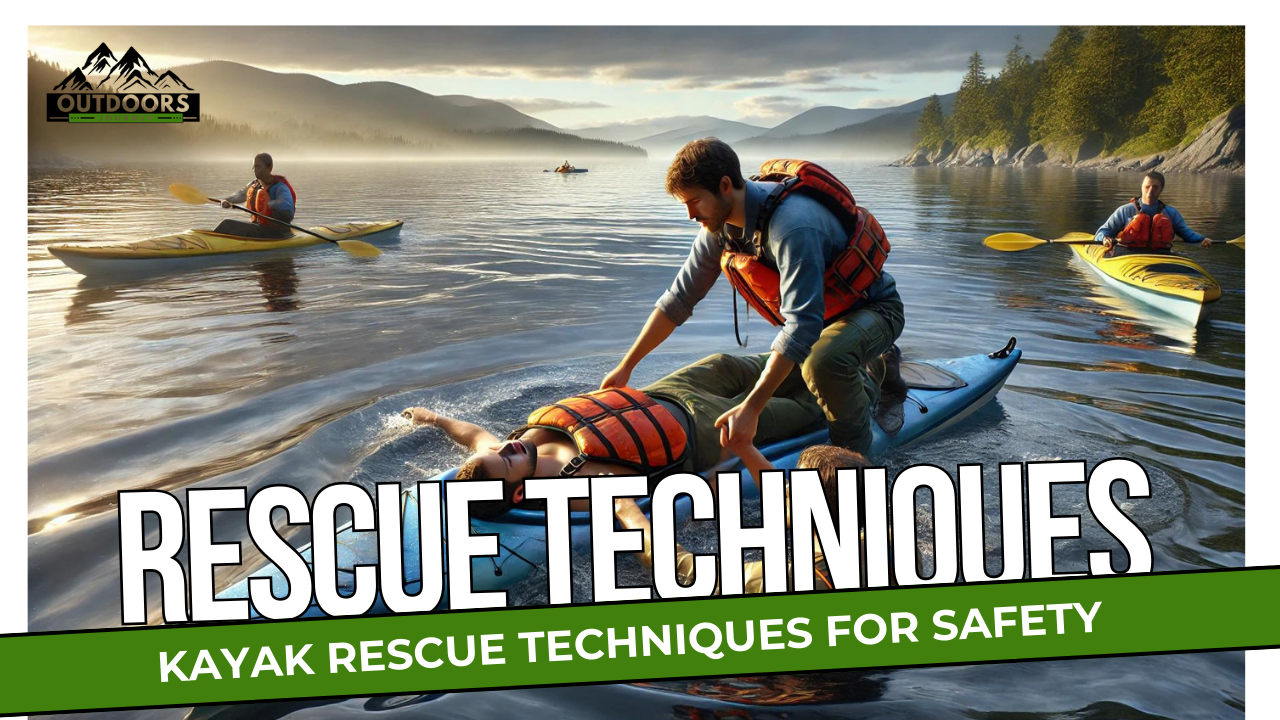Do you know that nearly 50% of kayaking accidents involve capsizing? This fact shows how crucial it is to know how to rescue yourself from a kayak. Whether you’re new to kayaking or have years of experience, learning how to recover from a capsized boat is key. It keeps you safe and helps you help others in emergencies.
This guide will teach you important self-rescue skills. You’ll learn about the gear you need and how to help other kayakers safely. By focusing on safety and practicing these techniques, you’ll make sure your time kayaking is fun and safe.
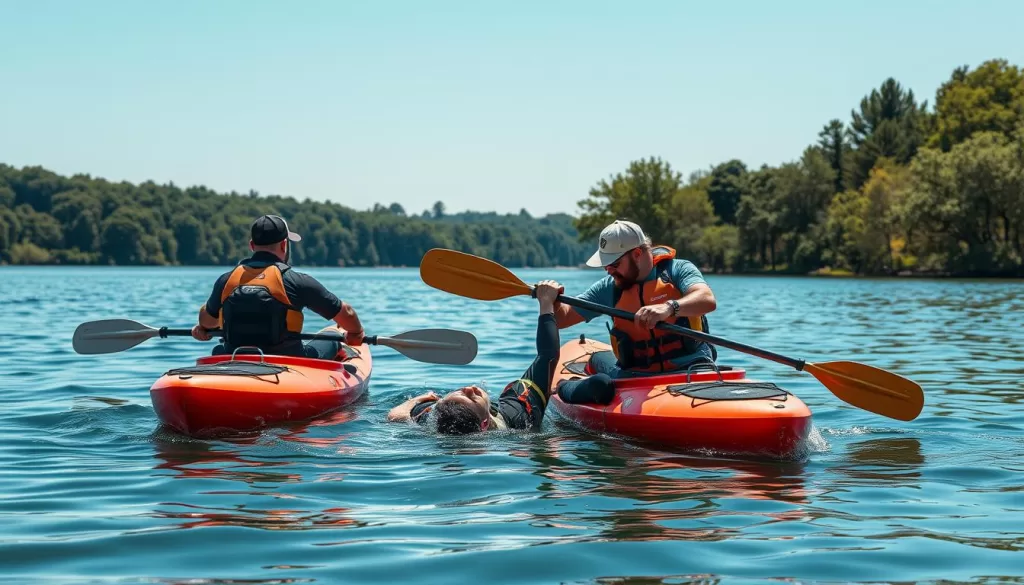
Key Takeaways
- Understanding kayak rescue techniques is vital for personal and group safety.
- Know the T Rescue, Heel Hook Rescue, and Paddle Float Self Rescue methods for effective recovery.
- Essential gear, like bulkheads and paddle floats, significantly enhances your ability to recover from capsizing.
- Practice these techniques in calm, warm waters to prepare for challenging conditions.
- Staying informed about personal limitations and communicating effectively during rescues is key to safety.
- 1 Introduction to Kayak Rescue Techniques
- 2 Understanding the Importance of Kayak Safety
- 3 Essential Equipment for Kayak Rescues
- 4 Types of Capsizes and Their Risks
- 5 Key Kayak Rescue Techniques
- 6 Executing the T Rescue
- 7 The Heel Hook Rescue Explained
- 8 Paddle Float Self Rescue Techniques
- 9 Practicing Kayak Rescue Techniques
- 10 Safety Protocols During Rescues
- 11 Working with a Paddling Partner
- 12 Challenging Conditions and Risk Management
- 13 FAQ
- 14 Source Links
Introduction to Kayak Rescue Techniques
Kayak rescue techniques are key to staying safe on the water. This introduction to kayak rescue covers important skills every paddler should know. Knowing different rescue types can greatly improve how you handle emergencies.
Learning rescue techniques means knowing how to help others and understanding why kayaks flip. Things like rough seas and mistakes by people make it more likely you’ll need these skills. In training, you learn about safety and how to talk things out when things get tough.
Groups like NOLS stress the need for hands-on practice in safe places. Training helps you learn to save yourself and be aware in different kayaking situations. Teachers push for learning and practicing with safety gear, like life jackets and paddle floats, to get ready for emergencies.
- Regularly improving your skills makes you better at saving yourself.
- Knowing about the environment helps you make smart choices on the water.
- Practicing rescue techniques builds confidence in doing them.
Learning kayaking safety skills prepares you for challenges. Being ready helps you and your paddling friends stay safe. It makes the whole kayaking community safer.
Understanding the Importance of Kayak Safety
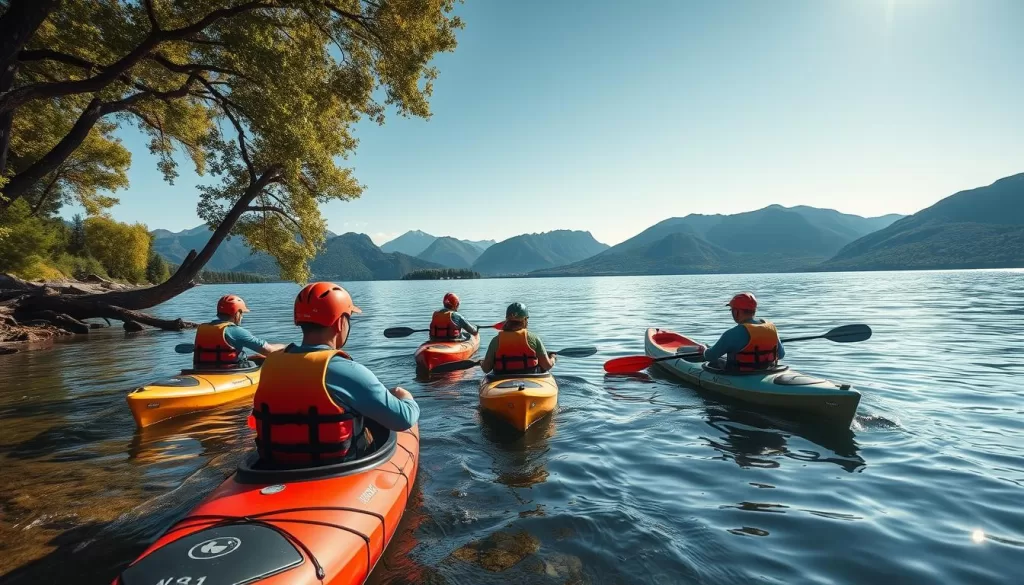
Keeping safe while kayaking is key for fun and secure times on the water. Knowing about kayaking accidents shows many come from capsizing, which can be very dangerous. This highlights the need for safety for both new and experienced kayakers.
Statistics on Kayaking Accidents
Reports show open ocean kayaking is riskier than calm waters. Being far from safety can make things worse in emergencies. Sadly, 84% of those who drowned in boating accidents weren’t wearing life jackets, showing how crucial they are.
Also, knowing how to swim is a must for kayakers, especially in mixed water conditions. It’s important to check your swimming skills in such situations.
Common Causes of Capsizing
Capsizing can happen due to rough water, sudden weather changes, or gear failures. These capsizing causes stress the need for training and being ready. Whitewater kayakers often learn to roll to avoid swimming, showing the importance of knowing rescue skills.
Using techniques like the T rescue, paddle-float rescue, and towing can lower the risk of capsizing in tough situations.
Essential Equipment for Kayak Rescues
Having the right gear is key for kayak rescues. Essential items boost safety and help with rescues. Knowing about these items gets you ready for unexpected water situations.
Importance of Bulkheads in Kayaking
Kayak bulkheads are vital for staying buoyant during rescues. They stop water from flooding the kayak. Without them, kayaks might tip over, making rescues hard, especially with the T-rescue method. So, make sure your kayak has strong bulkheads for better safety and rescue success.
Significance of Deck Lines
Deck lines are very important. They give rescuers a good grip on slippery kayaks in emergencies. In tough conditions, they help keep the kayak steady, making rescues easier. Always check that deck lines are in good shape and easy to reach for the best rescue results.
Utilizing Paddle Floats for Self-Rescue
Paddle float self-rescue is a lifesaver for kayakers in tough spots. It adds stability, making it easier to get back into your kayak. Keep a paddle float in your kayak to be ready for the unexpected. Practicing this method can make you feel more secure on the water.
Types of Capsizes and Their Risks
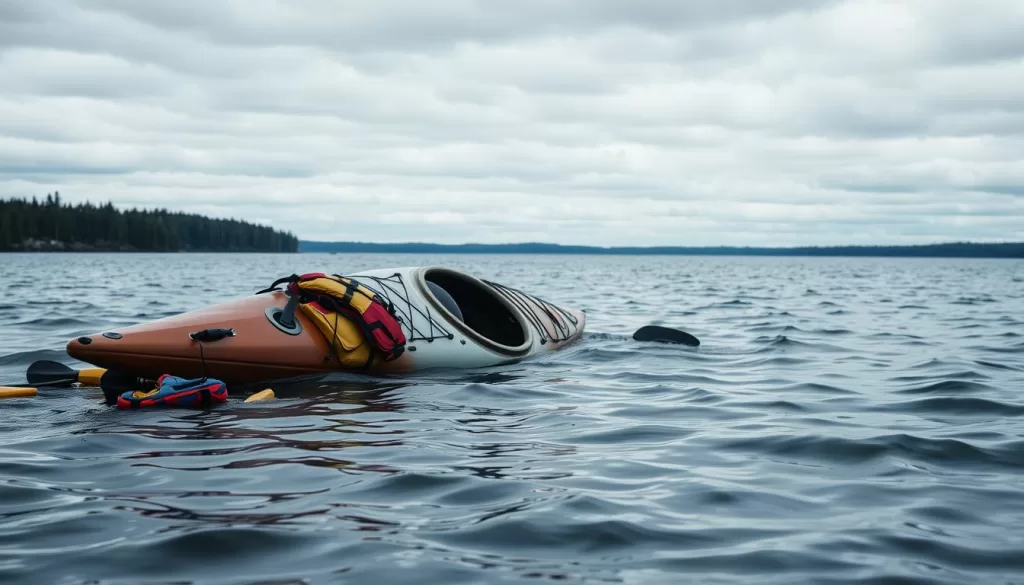
Knowing about different capsizes is key to staying safe while kayaking. It helps you get ready for unexpected events. Each capsize type brings its own set of challenges that need specific rescue methods.
Understanding Inverted and Swamped Boats
There are two main capsizes: inverted and swamped boats. An inverted boat turns upside down, trapping you underneath. This can be dangerous if you’re not ready, as you might lose your way or struggle to breathe. A swamped boat fills with water, making it hard to stay afloat and re-enter.
Identifying Common Hazards in Rough Conditions
In rough waters, several dangers can make capsizing more likely. High waves, strong winds, and poor control over your boat can all affect stability. The type of kayak you use matters; wider and heavier ones are more stable. Wrong paddling can also cause you to lose balance, making capsizing more likely. Knowing these risks helps you prepare for them.
Key Kayak Rescue Techniques
Learning key kayak rescue techniques boosts your confidence and safety on the water. Knowing different methods helps you handle unexpected situations well. It’s crucial for every kayaker, no matter their experience.
The T Rescue Method
The T rescue method needs teamwork. The rescuer stabilizes the capsized kayak while you get back in. Position your kayak at a right angle to the swamped one for a stable platform.
This teamwork approach makes getting back in easier. It also highlights the need for clear communication with your partner. When done right, it can save lives, making your return smooth.
Executing the Heel Hook Rescue
The Heel Hook rescue is great for those with less upper body strength. It uses your leg strength to get back into your kayak. Start by putting both feet on the kayak’s back, then use the heel hook to pull yourself up.
This method makes recovering easier for more kayakers. Getting better at it increases your confidence and skill.
Paddle Float Self-Rescue Steps
The paddle float self-rescue lets solo kayakers handle emergencies on their own. You’ll need a paddle float and a bilge pump for this. Begin with a wet exit, then attach the paddle float to your paddle.
Use it for leverage to climb back onto the kayak. Practicing these steps makes you more self-sufficient and improves your kayaking. Knowing how to use a paddle float can be a game-changer in tough situations.
Executing the T Rescue
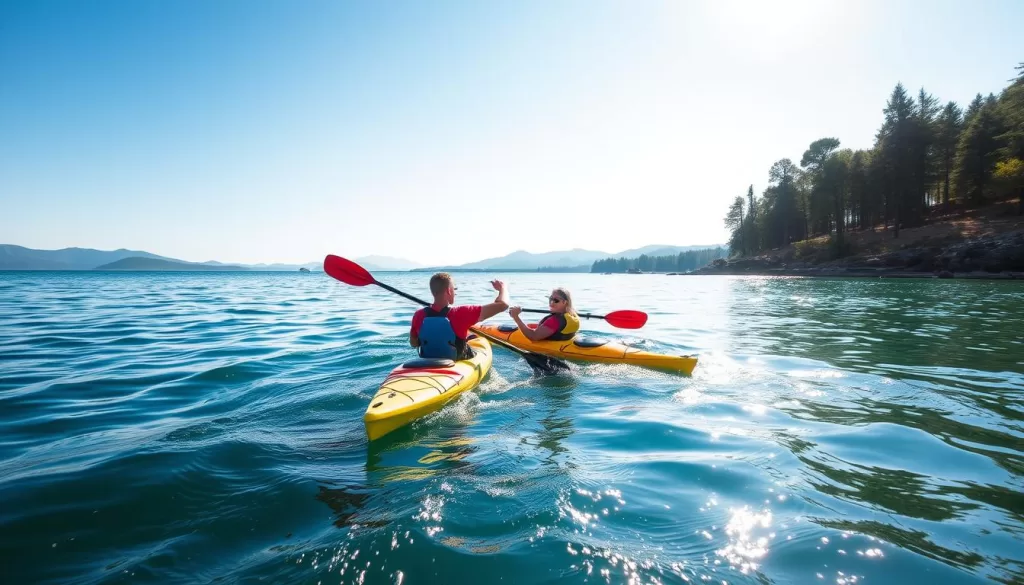
Executing the T rescue is key in many paddling situations, like when a kayak tips over. It starts with making the first contact in T rescue. This means getting to the swamped kayak safely.
Making Initial Contact with a Swamped Kayak
First, move your kayak towards the overturned one, aiming for the middle. It’s important to stay calm to avoid scaring the person in the water. When you’re near, make sure your kayak is set up right for the T rescue.
Steps to Efficiently Empty a Capsized Kayak
After getting into position, here’s how to empty a capsized kayak:
- Pick up the overturned kayak and put it on your lap, keeping both kayaks steady.
- Turn the kayak right side up to keep water from spilling out.
- Put the kayak back in the water, making sure it’s lined up right with yours.
- Use a bilge pump or a paddle float to get rid of any water left.
Practicing these steps will boost your confidence and make you better at real rescues.
The Heel Hook Rescue Explained
Learning the Heel Hook rescue technique is key for kayakers, especially if you struggle with upper body strength. This method uses your legs to help you get back into the kayak. It’s super useful in tough water conditions.
Technique for Kayakers with Less Upper Body Strength
The Heel Hook rescue is a lifesaver when you’re having trouble with traditional rescues. Here are some key points:
- It focuses on using your leg strength instead of just your arms.
- Practicing in different conditions builds confidence, even in rough waters.
- Watch out for mistakes like grabbing the deck lines incorrectly or losing balance.
Using Deck Lines for Stabilization
Deck lines are crucial for keeping the kayak stable during a Heel Hook rescue. Here’s how to use them right:
- After doing the leg hook, grab the deck lines for a solid hold.
- Keep your balance as you move into the kayak to avoid tipping over.
- Using gear like sling straps and foot bailers can make your rescue better.
Mastering the Heel Hook rescue and using deck lines can make kayaking safer.
Paddle Float Self Rescue Techniques
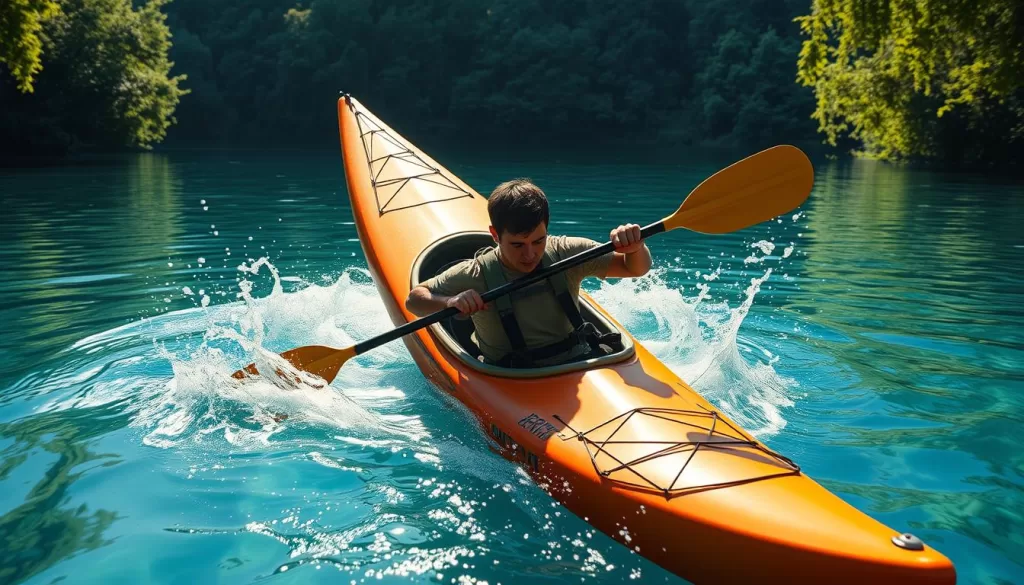
Paddle float self-rescue skills are key for kayakers at any level. They can greatly improve your safety on the water. Being ready with the right gear is crucial for self-rescue in tough situations. Having the right tools boosts your confidence and helps you recover successfully.
Essential Gear for Self Rescues
For a paddle float self-rescue, make sure you have these items:
- Paddle Float
- Bilge Pump
- Rescue Stirrup (optional)
- Perimeter Lines (if applicable)
Keep these items easy to reach so you can act fast if needed. A reliable paddle float is key. It adds buoyancy and stability when you try to get back into your kayak.
Steps to Secure Your Paddle Float
Securing the paddle float involves these steps for a better self-rescue:
- Attach your paddle float to the end of your paddle.
- Make sure the paddle float is fully inflated before using it.
- Place the paddle and float next to your kayak for balance.
- Use the paddle float’s buoyancy to stabilize your kayak as you get back in.
- Slowly move your weight onto the kayak while holding the paddle for support.
Using the paddle float in self-rescue helps you control your kayak and lowers the risk of capsizing. Practicing these steps builds your confidence and skill for emergencies.
Practicing Kayak Rescue Techniques
Regular kayak practice is key for learning rescue skills. Knowing these techniques boosts your confidence and helps you act fast in emergencies. The place where you practice greatly affects your learning. Practicing in warm, calm water lets you focus on rescue skills without the stress of tough conditions.
Why Warm, Calm Water is Ideal for Practice
Warm, calm water is perfect for both new and experienced paddlers. It’s a calm place to learn new skills. Here, you can:
- Become skilled at self-rescue moves.
- Work on reentries and paddle float techniques.
- Get more comfortable with getting in and out of a kayak.
This helps you prepare for tougher conditions later. It gets you ready for different situations you might find on the water.
The Importance of Regular Practice in Challenging Conditions
Practicing in tough conditions makes you more resilient and adaptable. These conditions bring their own set of challenges. It’s important to practice often to develop reliable techniques.
People who take offshore techniques classes say regular practice gets you ready for emergencies in unpredictable places. Learning self-rescue moves, like the T rescue or using a paddle float, makes you quicker to act in real situations.
Keeping your skills sharp through ongoing training helps you stay calm and focused in pressure situations. Knowing these methods means you’re prepared, even when practicing in tough conditions.
Safety Protocols During Rescues
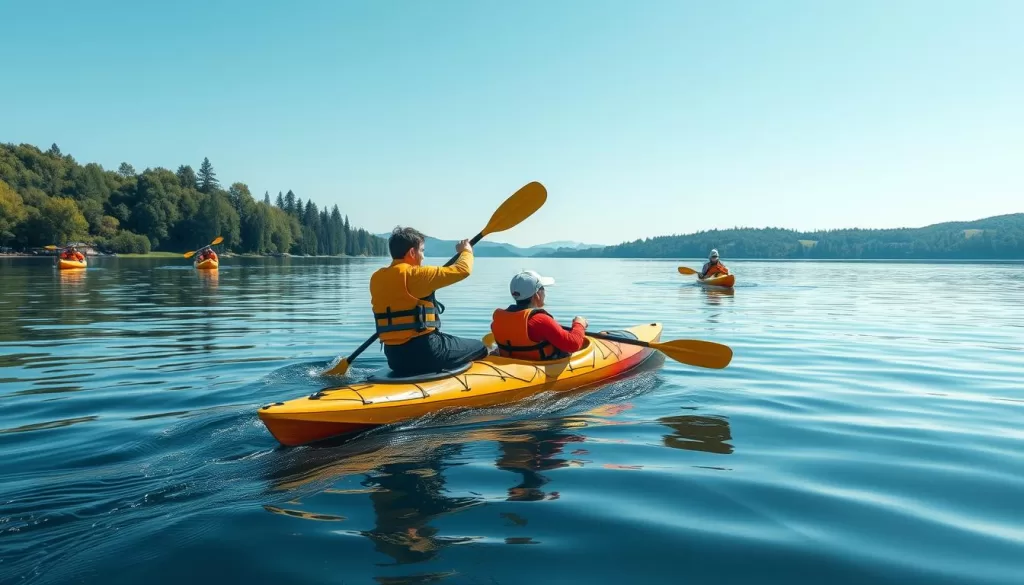
In kayaking, having safety plans for rescues is key. It’s crucial that everyone knows these plans. This can really help in emergencies.
Evaluating the Mental State of the Swimmer
When an accident happens, it’s important to check how the swimmer is feeling. Knowing if they are calm or panicked helps us know how to help them. Panic can lead to bad choices, so it’s key to see how they are feeling.
This helps us give the right kind of help. It could be reassuring them or telling them what to do next.
Leadership During Emergency Situations
Being a strong leader in emergencies is vital. As a rescuer, you need to take charge quickly and give clear orders. This helps keep things calm and safe for everyone.
Good communication is key for a smooth rescue. It makes sure everyone works together well. This increases the chances of a successful rescue.
Working with a Paddling Partner
Having a paddling partner makes kayaking safer. It’s key to talk clearly during rescues to make sure both know what to do. Teamwork is key to work together and act fast in emergencies.
Communicating Clearly During Rescues
It’s important to talk clearly with your partner during a rescue. Use signals or agreed-upon words to manage the situation well. Here are some tips for good communication:
- Establishing a plan: Talk about who does what before you go out.
- Using visual signals: Hand gestures or flags can send messages when it’s hard to hear.
- Verbal commands: Use short, clear words to give instructions when it’s stressful.
Benefits of Having Multiple Paddlers on the Water
Having more people in a kayak helps a lot in rescues. Working together means you can recover faster and more effectively. Here are some benefits:
- Shared responsibility: Sharing tasks lowers stress and keeps everyone focused.
- Increased safety: An extra person can prevent accidents and make things safer in emergencies.
- Enhanced technique: Practicing together lets you get better at different rescue methods and improve your teamwork.
| Aspect | Single Paddler | Multiple Paddlers |
|---|---|---|
| Communication | Limited to self | Collaborative and dynamic |
| Response Time | Slower due to individual action | Faster due to coordinated efforts |
| Safety | Higher risk | Lower risk, shared vigilance |
| Skill Development | Solo practice may limit learning | Learning from each other enhances skills |
Challenging Conditions and Risk Management
Before you start kayaking, it’s crucial to check the environment. Things like wind, waves, and currents can change how safe your trip will be. Knowing how to manage risks is key to staying safe, whether you’re new or experienced.
Assessing the Environment Before Kayaking
Start by looking at the weather forecast before you go. This helps you plan and avoid dangers from bad weather. Also, check the water quality to stay away from risks like Leptospirosis. It’s smart to learn how to spot dangers and handle emergencies too.
Tips for Kayaking in Rough Water
For rough water, having the right gear and skills is a must. Wear the right clothes and keep extra clothes, hot drinks, and snacks handy for emergencies. Having a leader for every four kayakers helps keep everyone safe. Good paddling skills and talking with your group can also make things safer and more fun.
FAQ
What are the essential kayak rescue techniques I should know?
Why is it important to understand kayak safety statistics?
What equipment is necessary for effective kayak rescues?
How can I perform a T rescue effectively?
What is the Heel Hook rescue method?
How do I carry out a paddle float self-rescue?
Why is practicing rescue techniques important?
How do I evaluate a swimmer’s mental state during a rescue?
What are the advantages of kayaking with a partner?
How do I assess environmental conditions before kayaking?
Source Links
- Learn these 3 Kayak Rescues – https://bendingbranches.com/blogs/resources/learn-these-3-kayak-rescues
- 6 Straightforward Steps To Complete The Kayak T-Rescue – https://paddlingmag.com/skills/safety-rescue-skills/t-rescue-kayak-technique/
- Sea Kayak Self-Rescue Techniques – NOLS – https://blog.nols.edu/sea-kayak-self-rescue-technique
- Sea kayak safety: the parallel rescue – https://www.westcoastpaddler.com/community/threads/sea-kayak-safety-the-parallel-rescue.9165/
- The Art of Sea Kayaking: Rescues and Rolling – https://paddlecalifornia.blogspot.com/2015/06/the-art-of-sea-kayaking-rescues-and.html
- Kayak Safety 101: Everything You Need To Know – Kayak Scout – https://www.kayakscout.com/kayak-safety/
- Kayak Safety 101 | Kayaking Safety Guidelines | EZ Dock – https://www.ez-dock.com/blog/kayak-safety-101/
- Kayak Gear and Accessories: Everything You Need To Go Kayaking – https://paddlingmag.com/skills/buying-advice/kayak-gear-and-accessories-everything-you-need-to-go-kayaking/
- T-Rescue Tune Up – https://kitchi-gami.com/2023/09/16/t-rescue-tune-up/
- How to Self Rescue If You Capsize – https://paddling.com/learn/how-to-self-rescue-if-you-capsize
- Kayaks Flip: Avoiding Accidents on the Water – https://www.lake.com/articles/kayaks-flip/
- Personal Challenge: 3 Rescue Techniques Every Kayaker Should Know – https://eddyline.com/blogs/news/personal-challenge-3-rescue-techniques-every-kayaker-should-know?srsltid=AfmBOooAvtvFPKonrm8jmEISiMLIqIERCQzkyiikKJMv-zbAnS4_KVMV
- Kayak Self Rescue Techniques – https://brooklynkayakcompany.com/blogs/our-blog-2/kayak-self-rescue-techniques?srsltid=AfmBOooHRh7RB9bAXwy89vZYCbToaRihVRK-glhFrhzKtjdDPpD_1K7s
- Kayaking Techniques – https://www.bask.org/kayaking-techniques/
- Classic T-Rescue with Variations – https://paddling.com/learn/classic-t-rescue-with-variations
- Rescue techniques for the unexpected? – https://forums.paddling.com/t/rescue-techniques-for-the-unexpected/66477
- Heel Hook Kayak Assisted Rescue – https://paddling.com/learn/heel-hook-kayak-assisted-rescue
- Kayak Heel Hook Rescue Techniques: Mastering Quick And Safe Recoveries – Kayakenjoy.com – https://kayakenjoy.com/skill-tips/heel-hook-rescue/
- Rescue techniques (split from Introduction and looking for advice) – https://www.ukriversguidebook.co.uk/forum/viewtopic.php?t=134517
- The Paddle Float Rescue: Why is Everyone Down on It? – https://www.paddlinglight.com/articles/the-paddle-float-rescue/
- How to teach self-rescues with sit-inside, recreational kayaks that do not have perimeter lines? – https://forums.paddling.com/t/how-to-teach-self-rescues-with-sit-inside-recreational-kayaks-that-do-not-have-perimeter-lines/117902
- Rescue Techniques – https://forums.paddling.com/t/rescue-techniques/23115
- Kayak Self Rescue Techniques – https://brooklynkayakcompany.com/blogs/our-blog-2/kayak-self-rescue-techniques?srsltid=AfmBOop6DUDQ2m2CbEXo5n_qh7X5OuU_L1OwsNAN0Vt4KJJTtbQcMTKS
- Beginners guide to… water safety – https://paddlerezine.com/beginners-guide-to-water-safety/
- Kayaking Safety Essentials: How to Stay Safe on the Water – Blazin’ Paddles – https://www.blazinpaddles.com/kayaking-safety-essentials-how-to-stay-safe-on-the-water/
- Kayaking Safety Measures and Rescue Techniques for Paddlers – https://kayakinginfo.com/kayaking-safety-and-rescue-techniques/
- PERFORM DEEP WATER-RESCUES — Kayak & Canoeing Training – http://www.kayaktrainingaustralia.com.au/perform-deep-waterrescues
- Your paddling partner collapsed!!! And what would you do? – https://www.westcoastpaddler.com/community/threads/your-paddling-partner-collapsed-and-what-would-you-do.3539/
- The Art of Sea Kayaking: Rescues and Rolling – https://paddlecalifornia.blogspot.com/2015/06/
- insure4boats.co.uk – https://www.insure4boats.co.uk/blog/archive/kayaking-risk-assessment/
- 5 Risk Management Tips for Guided Kayaking Tours – Prime Insurance Company – https://www.primeis.com/education-center/articles/5-risk-management-tips-for-guided-kayaking-tours/
